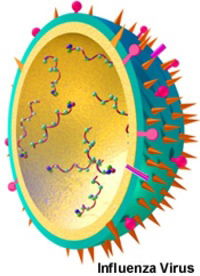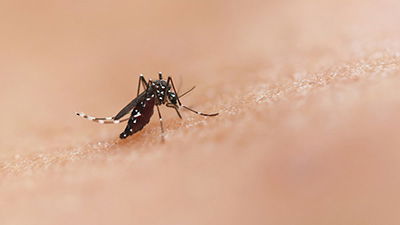Swine Flu—Cause for Concern?
The latest influenza outbreak has people in a panic. What should Christians think?
The latest influenza outbreak has people in a panic. What should Christians think?
At a Glance
- An outbreak of swine flu in humans has spread from Mexico to several other countries. More than 100 are believed to have died from the outbreak so far.
- Swine flu is a Type A influenza virus, with symptoms similar to other forms of influenza. Doctors recommend the usual precautions (washing hands frequently, covering mouth during coughs and sneezes, and avoiding any contact with infected persons).
- All forms of influenza present a real danger to people, and for that reason preparedness and precaution are important. However, there are several reasons not to panic.
See also maps of the outbreak.
Stories of “swine flu” have dominated news outlets this week, hearkening back to outbreaks of SARS and bird flu in years past. Are we in for a pandemic?
(Last updated September 21, 12:30 p.m. EDT—see below) The 2009 outbreak of swine flu—technically swine influenza A (H1N1)—began with a single known case in the state of Veracruz, Mexico, on April 2. In the weeks since, swine flu has spread to several other countries and is suspected of killing more than 150 in Mexico and hospitalizing 1 in the United States.1 In Mexico, authorities have closed all schools while individuals across the country have donned surgical masks; more than 2,000 possible cases have been reported at Mexican hospitals.2 Police even kept people away from a sold-out soccer game in a bid to reduce the spread of infection.3
In the United States, Dr. Richard Besser, acting head of the Centers for Disease Control and Prevention, said that Americans should be prepared for the problem to become more severe, and that it could involve “possibly deaths.” U.S. officials declared a public health emergency after swine flu infected at least 40 individuals, with a concentration of 28 cases in New York City.4 Cases have also been reported in Canada, Spain, New Zealand, Scotland, France, Italy, and Israel.5
So what are we to think? What is swine flu, how dangerous is it, and is there cause for real concern—or is this just media hype?
Updates
- April 29, 10 a.m. EDT—A 23-month-old Texas girl was the first victim of swine flu in the U.S. The child was from Mexico and had recently been there, reports BBC News.6 There are now at least 63 confirmed cases of swine flu in the U.S., 13 in Canada, 13 in Europe, 3 in New Zealand, and 2 in Israel.
- April 29, 2 p.m. EDT—Increases in the confirmed number of cases of swine flu: now 91 in the U.S., 23 in Europe.7
- April 30, 9 a.m. EDT—Mexico is suspending all nonessential activities of both government and private business through May 5 in a bid to slow the spread of swine flu.8 According to MSNBC, the virus is now believed to have made nearly 2,500 sick and hospitalized more than 1,300 in that country. The World Health Organization has raised its pandemic alert status for swine flu to phase five, indicating that a pandemic is imminent—indicated by human-to-human transmission of the virus in at least two countries.9
- April 30, 4 p.m. EDT—Updated numbers of confirmed swine flu cases: U.S., 109; Europe, 24; Canada, 19; New Zealand, 3; Costa Rica and Israel, 2 each; Peru, 1. Suspected swine flu deaths in Mexico have now reached 168.
- April 30, 5 p.m. EDT—The Los Angeles Times reports that swine flu “may not even do as much damage as the run-of-the-mill flu outbreaks that occur each winter without much fanfare.” The article serves as a good reminder of why not to panic.
- May 1, 2 p.m. EDT—The number of confirmed cases of swine flu continues to grow, now at 331 worldwide.10 However, BBC News explains why H1N1 (swine flu) may hopefully be “a fairly mild strain” of influenza.
- May 2, 5 p.m. EDT—Both encouraging and discouraging news: on one hand, BBC News reports that Mexico has reduced its suspected swine flu death toll and infection rate figures, and that the World Health Organization believes there is “no evidence of sustained community spread outside of North America.” However, CNN reports a jump in confirmations of swine flu, partially due to a backlog in testing in Mexico. Another CNN article reminds readers to be discerning before heading to the emergency room: “The situation is that people get the flu all the time. H1N1 flu is just a bad strain of that. If you have flu symptoms and you ordinarily see the doctor for that, go ahead. If you would not ordinarily go to the doctor, don’t,” explained Nick Jouriles, president of the American College of Emergency Physicians.
- May 4, 4 p.m. EDT—Numbers of confirmed cases of swine flu continue to rise, with nearly 300 in the U.S. and more than 100 in both Canada and Europe. But Mexican president Felipe Calderon has said that swine flu is in a “phase of decline” in that country.11
- May 5, 5 p.m. EDT—BBC News reports that a second person has died from H1N1 (swine) flu in the United States.12 The Texas resident had “chronic underlying health conditions,” according to the Texas Department of State Health. Earlier, U.S. Health and Human Services Secretary Kathleen Sebelius said that H1N1 “does not seem to be as severe as we once thought it would be.”13 Meanwhile, the World Health Organization reports that 1,490 cases of H1N1 have been confirmed worldwide.14
- May 12, 1 p.m. EDT—Although news media have grown much more quiet about H1N1, the virus continues its worldwide spread and has now killed 3 in the U.S. as well as 1 in Canada and 1 in Costa Rica.15 The number of confirmed infections in the U.S. is now up to 2,532, surpassing even Mexico.16 A recent analysis suggested swine flu could infect a third of the world’s population in the next six to nine months, with a mortality rate of perhaps 4 out of every 1,000 persons infected.17
- June 3, 11:30 a.m. EDT—Nearly a month has passed with relative silence from the media about swine flu. However, Reuters reports that H1N1 continues to spread around the globe, with some 19,000 infected persons in 64 countries and 117 confirmed deaths. “It is probably fair to call the situation something like moderate right now. We do have some hesitation to call the situation mild,” said Keiji Fukuda, acting assistant director-general for the World Health Organization.18
- June 14, 9 p.m. EDT—H1N1 is now officially a pandemic, according to the World Health Organization. That pronouncement relates to the virus’s spread, not to its medical danger. The Associated Press reports that some 29,000 people in 74 countries have been infected with the virus to date; 144 have died—about half of them young and previously healthy. However, the AP notes, “[S]cientists have grown to understand that the virus is generally not much more severe than the seasonal flu,” while the WHO still uses the “moderate” label for swine flu. “Understand it, put it in context, and then you get on with things,” explained WHO flu chief Keiji Fukuda.19
- July 17, 11 a.m. EDT—According to the World Health Organization, H1N1 is “the fastest-moving pandemic ever” and thus it is now “pointless to count every case,” reports Reuters. Instead, the WHO asks countries to report clusters of severe cases or deaths caused by the virus. The WHO considers the H1N1 pandemic unstoppable. As of July 6, the worldwide death toll from H1N1 stood at 429; experts suggest over a million may have been infected in the U.S. alone. Thankfully, H1N1 can be treated by antiviral drugs, and many patients are recovering without medical treatment.20
- September 21, 12:30 p.m. EDT—As infections and deaths from H1N1 continue to accumulate (with a total of nearly 4,000 deaths worldwide21), vaccines against the flu are finally ready for the public. The Associated Press reports that the U.S. Food and Drug Administration has approved a vaccine manufactured by French firm Sanofi-Aventis that will be in use by mid-October.22 A separate nasal spray vaccine will also be ready by October, though the nasal spray vaccine is only recommended for certain groups.23
Overview: What Is Swine Flu?

Although swine flu does live in pigs, the variant of H1N1 responsible for the current outbreak has bird, pig, and human components.24 (Credit: Guido Gerding via Wikimedia Commons)
Swine flu is a Type A influenza virus, meaning it can infect not only people, but also a variety of animals.25 The symptoms of swine flu are those of other types of influenza, and include fever, body ache, extreme fatigue, sore throat, dry cough, and lack of appetite. Some also report having a runny nose, nausea, vomiting, and diarrhea.26 Symptoms show up within a few days after the initial infection. Individuals may be contagious both before and after they show symptoms, and some infected individuals may never show symptoms.27
Human infection is usually a result of a human having direct contact with an infected pig. The human may then transfer the infection to another person—or even back to a pig.28
One reason for alarm over swine flu is the speed of international travel, which can transmit the flu (through infected humans) literally around the world in a day.29
History
Swine flu was first isolated in pigs in 1930. In 1976, a swine flu outbreak in the U.S. led to vaccinations of some 40 million people before the vaccinations were halted amid controversy.30
In 1998, an outbreak of swine flu in the U.S. state of Wisconsin led to multiple human infections. MSNBC reports that “[a]bout one case of swine flu in humans is reported to the CDC every one to two years, but from December 2005 through February 2009, 12 cases were reported to the agency. According to WebMD.com, 11 of those people had direct or indirect contact with infected pigs.”31 Additionally, scientists have been urging more swine flu vigilance for the past several years.32
Prevention
Since swine flu is a type of influenza, the best preventative measures are no surprise: frequent hand-washing (with soap- or alcohol-based sanitizers); avoiding contact with sick people; and possibly wearing a face mask. Despite some countries’ immediate restrictions on pork imports, swine flu cannot be contracted through eating pork products as long as they are properly cooked.33
A key difference that has become apparent between swine flu and more common types of influenza is that swine flu has killed several young, otherwise healthy individuals. (Most types of flu are more dangerous for young children and the elderly.)34

An illustration of the influenza virus. (Credit: NIAID)
The U.S. Centers for Disease Control reports that, according to laboratory testing, the swine flu virus is susceptible to the prescription antiviral drugs oseltamivir (tamiflu) and zanamivir (relenza), two of the four antiviral drugs in the U.S. licensed for flu treatment. (Swine flu is resistant to the other two drugs.35) The drugs are effective against the new strain when taken early. There is currently no vaccine for H1N1 swine flu.36
What’s a virus?
A virus is a non-living sub-microscopic infectious entity that essentially “takes over” living cells in order to reproduce. The virus that causes swine flu is similar to viruses that cause human flu and the symptoms are similar. Information compiled by several U.S. government agencies states that on average 30 to 50 percent of commercial U.S. swine are infected with swine flu.37 However, the death rate in infected swine is low.38 Typically, swine flu does not infect humans but occasionally it mutates and then is capable of infecting humans. Contact with pigs is usually necessary to “catch” swine flu but sometimes it mutates further and is transmissible from human to human (this appears to have occurred in the most recent outbreak).
An evolution connection?
Disease and a loving God
Many people wonder how an all-powerful, loving God could create a world in which there are things like viruses, diseases, epidemics, and death. But the Bible teaches us that God created the world “very good” (Genesis 1:31), and only after Adam and Eve disobeyed God did death enter the world (Genesis 3:19, 22). All of God’s creation still suffers from the effects of sin (Romans 8:20–22). But God sent His Son as a “last Adam” to redeem our souls (1 Corinthians 15:45), and thus those in whom Jesus lives have hope for the day when death will be swallowed up in victory (1 Corinthians 15:54) and when there will be “no more death, neither sorrow, nor crying, neither shall there be any more pain” (Revelation 21:4).
(For a complete answer, read Why Does God’s Creation Include Death and Suffering? and see Get Answers: Death & Suffering. To learn how you can enjoy eternal life through God’s only Son, read the Good News!)
At first, the swine flu outbreak may seem to have little or nothing to do with biblical Christianity in particular. However, any time groups of people are dying from what appears to be nature (i.e., in this case, a virus), we receive questions about how a loving God could allow such tragedy (read the answer in the sidebar, right).
Additionally, news media commonly report that viruses such as influenza types are constantly “evolving” and thus thwarting medical treatments.39 The public perception likely mirrors the thoughts of one commenter on a LiveScience article who wrote, “It should also be said that this flu, although relatively a mild influenza as of now, can possibly evolve into a deadlier strain. . . . An extremely virulent and evolving strain could be devastating.”
Flu viruses in general do “evolve” but not in the molecules-to-man sense. Rather they mutate and these changes allow them to infect multiple hosts (pigs and humans) and/or change their mode of transmission (pig to human changes to human to human). These mutations do not add information (as required for molecules-to-man evolution) but rather alter the current information for host specificity and mode of transmission. For more information on viruses from a creationist perspective see:
- Genetic Variance of Influenza Type A Avian Virus and its Evolutionary Implications
- Were Retroviruses Created Good?
Is there Cause for Concern or Fear?
“What You Can Do to Stay Healthy” (CDC Tips)
There are everyday actions people can take to stay healthy.
- Cover your nose and mouth with a tissue when you cough or sneeze. Throw the tissue in the trash after you use it.
- Wash your hands often with soap and water, especially after you cough or sneeze. Alcohol-based hands cleaners are also effective.
- Avoid touching your eyes, nose or mouth. Germs spread that way.
Try to avoid close contact with sick people.
- Influenza is thought to spread mainly person-to-person through coughing or sneezing of infected people.
- If you get sick, CDC recommends that you stay home from work or school and limit contact with others to keep from infecting them.
For reliable, up-to-date information, visit the Centers for Disease Control Swine Influenza (Flu) page.
Best practices
Our first line of defense against swine flu is simple and easy to do: “Basic cleanliness that your mom taught you,” remarked Ken Ham when he was addressing the AiG staff on this issue. Wash your hands frequently with soap or alcohol-based hand sanitizer; cover your mouth with a tissue when you cough or sneeze, and dispose of the tissue immediately; and avoid touching your eyes, nose, or mouth with unclean hands. If you are sick and your symptoms are mild, stay home from school or work; however, head to the doctor’s or to a hospital if your symptoms get worse or if you have trouble breathing.40 Those ill especially should avoid travel.41 See the full list of CDC guidelines (right) for more.
Why the concern?
If defense against the flu is so routine, why all the media coverage and official concern?
- The historical record. The 1918 “Spanish” flu pandemic killed between 50 and 100 million people, and the 1968 “Hong Kong” flu killed about 1 million.42 Considering that, everyone from world leaders to local health officials would prefer to err on the side of caution. Furthermore, there is a great deal of uncertainty about where the outbreak could head next. Swine flu is “something that could literally die out over the next couple of weeks and never show up again—or this could be the opening act of a full-fledged influenza pandemic. We have no clue right now where we are between those two extremes,” explained flu expert Michael Osterholm of the University of Minnesota.43
- Because swine flu is not common in humans, individuals do not generally have any immunity to it, thus making it spread more quickly than common human types of influenza would.
- There are lingering questions about why young, otherwise healthy people are dying from swine flu. Usually most influenza deaths are in the very young and elderly.44
No room for fear
“News of a new swine flu in humans seemed to spread faster worldwide than the virus itself in recent days,” quipped LiveScience senior editor Robin Lloyd.45 Despite the media hype and cause for reasonable concern, panic is unjustified for several reasons:
- Of the 20 cases of swine flu reported in the U.S. up to April 26, only one required a “brief” hospitalization. By Monday, April 27, half of all cases in the U.S. were connected to a single New York City school.46 Furthermore, the World Health Organization has not recommended any travel or trade restrictions.47
- MSNBC reports that “[t]he number of confirmed swine flu cases in the U.S. has climbed to 42, but that is still a tiny fraction of all influenza, which typically causes an estimated 226,000 hospitalizations and 36,000 deaths in the nation every year.”48
- The virus has been much more deadly in Mexico, perhaps because many cases have gone unreported and thus untreated, falsely making the mortality rate appear to be much higher. Mexico’s public health system is also more overextended than more developed countries’.49
- The number of new cases of swine flu reported by Mexico’s largest government hospitals has been dropping since April 25.50
Besides, in every situation, we should remember the words of Christ in Matthew 6:25–27:
Therefore I say to you, do not worry about your life, what you will eat or what you will drink; nor about your body, what you will put on. Is not life more than food and the body more than clothing? Look at the birds of the air, for they neither sow nor reap nor gather into barns; yet your heavenly Father feeds them. Are you not of more value than they? Which of you by worrying can add one cubit to his stature?
While a Christian can show reasonable concern over current events and undertake necessary and proper actions to counteract and prepare for the “worst-case scenario,” there is no room for panic in the Christian heart. Instead, be vigilant (as always!), pay attention to reports from the CDC for updates, and keep the affected in your prayers.
For more information:
- Associated Press: What you need to know about swine flu
- ScienceInsider: Recently in Swine Flu Category
Google Maps showing the H1N1/swine flu outbreak in 2009 (these images may be out of date—click maps to see latest information):


Wikipedia Maps showing swine flu spread worldwide and in North America (these images may be out of date—click maps to see latest information). Black: confirmed deaths from swine flu. Red: confirmed infections by swine flu. Orange: suspected infections by swine flu.


MSNBC also has an online map tracking the outbreak.
Footnotes
- http://cnnwire.blogs.cnn.com/2009/04/27/all-schools-closed-in-mexico-4/
- http://cnnwire.blogs.cnn.com/2009/04/27/all-schools-closed-in-mexico-4/ & http://news.bbc.co.uk/2/hi/in_pictures/8020326.stm
- http://news.bbc.co.uk/2/hi/americas/8021483.stm
- http://www.cdc.gov/swineflu/?s_cid=swineFlu_outbreak_internal_001 & http://www.physorg.com/news160054428.html
- http://www.newsdaily.com/stories/tre53n228-us-flu/ & http://www.physorg.com/news159972831.html
- http://news.bbc.co.uk/2/hi/americas/8024611.stm
- http://news.bbc.co.uk/2/hi/americas/8024611.stm
- http://www.msnbc.msn.com/id/30487509/
- http://www.who.int/mediacentre/news/statements/2009/h1n1_20090429/en/index.html & http://news.bbc.co.uk/2/hi/americas/8025931.stm
- http://www.cnn.com/2009/HEALTH/05/01/swine.flu.outbreak/index.html
- http://news.bbc.co.uk/2/hi/americas/8032582.stm
- http://news.bbc.co.uk/2/hi/americas/8034991.stm
- http://www.cnn.com/2009/HEALTH/05/05/swine.flu.main/index.html
- http://news.bbc.co.uk/2/hi/americas/8034991.stm
- http://news.bbc.co.uk/2/hi/asia-pacific/8042374.stm
- http://news.bbc.co.uk/2/hi/americas/8043458.stm
- http://news.bbc.co.uk/2/hi/health/8045364.stm
- http://www.reuters.com/article/healthNews/idUSTRE5514R920090602
- http://www.google.com/hostednews/ap/article/ALeqM5jTkkEKE5LtPih_5Jcc-3MpD0gOYQD98ONHDG0
- http://www.reuters.com/article/homepageCrisis/idUSLG309223._CH_.2400
- http://www.ecdc.europa.eu/en/healthtopics/Documents/090921_Influenza_AH1N1_
Situation_Report_0900hrs.pdf - http://www.google.com/hostednews/ap/article/ALeqM5goK-pCbdtGRYh0qjGTEFYM2sXMTwD9ARJT100
- http://www.nytimes.com/2009/09/19/health/19flu.html
- http://www.physorg.com/news160054720.html
- http://www.livescience.com/health/090426-sr-flu-basics.html
- http://www.msnbc.msn.com/id/30390176/?pg=4#SwineFlu_QA
- http://www.livescience.com/health/090426-sr-flu-basics.html
- http://www.msnbc.msn.com/id/30390176/?pg=3#SwineFlu_QA
- http://www.livescience.com/health/090426-sr-flu-basics.html
- http://blogs.sciencemag.org/scienceinsider/2009/04/retrospective-w.html & http://www.livescience.com/health/090428-pandemic-primer.html
- http://www.msnbc.msn.com/id/30390176/?pg=3#SwineFlu_QA
- “Swine flu monitoring needed for farm workers, study says,” University of Alberta news release,” February 11, 2008; “Agricultural workers at increased risk for infection with animal flu viruses,” National Institutes of Health news release, November 28, 2005; “US swine workers at increased risk of infection with swine influenza virus,” Infectious Diseases Society of America news release, November 23, 2005
- http://www.msnbc.msn.com/id/30390176/?pg=3#SwineFlu_QA & http://www.cdc.gov/swineflu/pdf/brochure.pdf
- http://news.bbc.co.uk/2/hi/americas/8020676.stm
- http://700wlw.com/cc-common/seasonal/health/sub.html?feed=104777&article=5377295&lc=health
- http://www.msnbc.msn.com/id/30390176/?pg=6#SwineFlu_QA
- http://www.cdc.gov/swineflu/pdf/brochure.pdf
- http://www.msnbc.msn.com/id/30390176/?pg=2#SwineFlu_QA
- http://www.msnbc.msn.com/id/30398682/
- http://www.msnbc.msn.com/id/30423456/
- http://www.msnbc.msn.com/id/30398682/
- http://www.cnn.com/2009/HEALTH/04/27/swine.flu/index.html & http://www.livescience.com/health/090428-pandemic-primer.html
- http://www.physorg.com/news160030889.html
- http://www.msnbc.msn.com/id/30423369/
- http://www.livescience.com/health/090427-flu-q-and-a.html
- http://www.newsdaily.com/stories/tre53n228-us-flu/ The school is St. Francis Preparatory School, some of whose students went on a spring break trip to Cancun, Mexico, in the first half of April. (See http://www.physorg.com/news159966680.html)
- http://www.who.int/csr/don/2009_04_26/en/index.html
- http://www.msnbc.msn.com/id/30434944/ (Updated May 4, 4 p.m. EDT: Some took us to task for reporting this number, but as we said, it is an estimate [based on previous CDC research]. Just because it’s an estimate doesn’t automatically make it an overestimate.)
- http://www.physorg.com/news159946708.html
- http://www.msnbc.msn.com/id/30398682/

Answers in Genesis is an apologetics ministry, dedicated to helping Christians defend their faith and proclaim the good news of Jesus Christ.
- Customer Service 800.778.3390
- Available Monday–Friday | 9 AM–5 PM ET
- © 2025 Answers in Genesis




